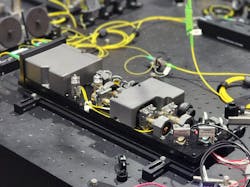Editor's note: Listen to our podcast interview with Noel Goddard below, which we released on April 2, 2024.
Laser Focus World: Can you introduce us to Qunnect?
Noel Goddard: Qunnect is developing the first complete hardware stack for quantum networking built for real-world deployment. Our product suite works on existing telecom fiber: devices are housed in standard server racks and operate at room temperature, without the need for extreme cooling or vacuum support.
We’ve already achieved several breakthroughs, including launching GothamQ, our quantum networking testbed in New York City, to demonstrate high-rate and high-quality entanglement distribution.
Our approach to long-distance, quantum-secure communication protocols is based on entanglement distribution and preservation, and we’re the first company to commercialize a quantum memory device. Building upon this, we’ve expanded our offerings to include QU-SOURCE, which produces exceptionally pure polarization-entangled photon pairs; QU-LOCK, a high-precision, multifrequency laser reference; and QU-APC (auto polarization compensator), a device to actively compensate for real-time fiber noise due to environmental perturbations.
LFW: How about an overview of QU-Source?
Goddard: QU-SOURCE leverages a spontaneous four-wave mixing (SFWM) within an atomic vapor (rubidium) to produce highly pure polarization-entangled photon pairs. The process uses two pump lasers to excite the atoms, while the decay process emits a bichromatic pair. Our choice of pump lasers defines the output wavelengths. In our case, we produce pairs where one photon is in the near-infrared (795 nm) and the other is in the telecom O-band (1324 nm) for a natural interface between atomic devices, like our quantum memories and telecom fiber transmission.
The majority of academic and commercial entanglement sources use spontaneous parametric downconversion, a process that uses lasers to pump a series of crystals due to the simplicity of the optical system and the ability to produce high pair generation rates—but the resulting photon pairs have very large linewidths (>THz). While these photons can be used for communication protocols like quantum key distribution (QKD), they can’t interface to other quantum devices without significant losses. This was the motivation for building our own atomic-based source.
Atoms naturally produce narrow-linewidth photons (less than GHz
QU-SOURCE optimizes a number of parameters to control light-matter interactions within the vapor cell to maximize the number of atoms—collectively generating pairs of entangled photons while minimizing negative effects such as atomic absorption to achieve generation rates of >10 million pairs/s with sub-GHz linewidths.
LFW: What kind of lab setup is required?
Goddard: Qunnect currently sells the QU-SOURCE optics and the QU-LOCK laser reference module. Users need to provide the two pump lasers. But stay tuned: we’re currently building a rack-mounted product that incorporates both pump lasers, locking electronics, and the QU-LOCK module. We plan to release it in early 2024.
LFW: Coolest thing you can do with your technology so far?
Goddard: On April 14, 2023, a.k.a. World Quantum Day, we debuted our GothamQ network in New York City. This is a quantum networking testbed driven by QU-SOURCE, QU-LOCK, and QU-APC. Since then, we routinely use QU-SOURCE to inject millions of photon pairs per second into 34 kilometers (21.1 miles) of pre-existing commercial-grade telecom fiber.
With 17 dB transmission loss in the fiber, we’re still capable of preserving >130,000 photon pairs/s with exceptionally high S-value (2.7) and low QBER (<2.5%). Importantly, the QU-SOURCE design is upwardly compatible with long-distance quantum networking, supported by quantum repeaters. We’re also optimizing the interface between QU-SOURCE and QU-MEM, our quantum memory. Quantum memories provide temporal control over optical networks and are the key enabling technology for quantum repeaters.
LFW: What are your future goals for the company?
Goddard: In September, we successfully distributed and preserved entanglement over 16 kilometers (10 miles) of real fiber, as part of the GothamQ network node that connects to New York University. We’ll be hosting more collaborative experiments with strategic partners on our GothamQ network in the near term, and our products will be installed on several other networks being built in the U.S. and E.U.
We remain focused on innovating first-in-class products that transform existing telecom infrastructure into quantum networks and revolutionize secure communications, distributed quantum sensing, and computing. We’re encouraged by the performance of our products like QU-SOURCE and QU-APC and are excited for customers and collaborators to give us feedback as they start using them in their research.
Qunnect’s new projects will include creating physical protection to digital data streams with QU-SOURCE and the industrial-hardening of our current product suite—opening the market to network engineers and researchers.
For more technical information about QU-Source, check out their paper on arXiv: https://www.qunnect.inc/files/qu-source.pdf.

